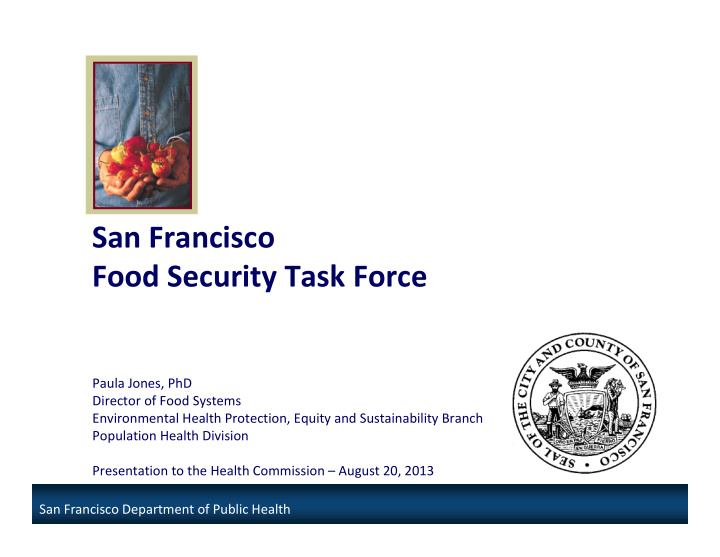



San Francisco Food Security Task Force Paula Jones, PhD Director of Food Systems Environmental Health Protection, Equity and Sustainability Branch Population Health Division Presentation to the Health Commission – August 20, 2013 San Francisco Department of Public Health
Overview of the Presentation 1. What is food security? State in which all persons obtain a nutritionally adequate, culturally acceptable diet at all times through local non emergency sources 2. Background on Food Security Task Force (FSTF) 3. Assessment report 4. Next steps San Francisco Department of Public Health 2
Background on the Food Security Task Force 1. History a. Board of Supervisor’s (BOS) task force created in 2005 Goal ‐ Ending hunger and enhancing food security b. Currently authorized until July 1, 2015 c. Past projects 2. Members a. City agencies ‐ total 7 b. Community members ‐ total 8 San Francisco Department of Public Health 3
Current Activities of the Food Security Task Force 1. Priorities: a. Maximizing utilization of federal funded nutrition programs b. Expanding food resources for populations/neighborhoods not covered by current government programs c. Improve access and knowledge to obtain and prepare healthy, nutritious food d. Improve coordination of food rescue and decrease food waste 2. Projects: a. Assessment of hunger and food insecurity in San Francisco b. Expand use of the USDA funded After School Meals program c. Increase food security among residents of SROs, homeless and disabled d. Expand Restaurant Meals Program e. Represent San Francisco to the California Food Policy Council San Francisco Department of Public Health 4
Landscape of Food Insecurity 1. Income – 28% of San Franciscans live < 200% of FPL 2. Food insecurity (adults < 200% FPL) Year San California Francisco 2007 20.4% 34.8% 2009 44.3% 40.7% 2011/12 30.4% 41.7% (California Health Interview Survey) 3. Food insecurity ‐ children a. 27% California b. 22.4% Nationally San Francisco Department of Public Health 5
Assessment of Food Security In San Francisco 1. Goals 2. Methods a. Utilized modified WHO food security framework b. Analysis of secondary data c. Present data by supervisorial district San Francisco Department of Public Health 6
Framing the Discussion – Pillars of Food Security / Healthy Eating 1. Food Resources The ability to secure sufficient financial resources to purchase • enough nutritious food to support a healthy diet on a consistent basis ($, CalFresh (food stamps), WIC, SSI) 2. Food Access The ability to obtain affordable, nutritious and culturally • appropriate foods safely and conveniently (meal programs & food retail) 3. Food Consumption Ability to prepare healthy meals using knowledge of basic • nutrition, safety and cooking (kitchens and nutrition/cooking education) San Francisco Department of Public Health 7
Food Security and Healthy Eating ‐ Complex Policy Issues Example: Food Security in SROs Food Resources Food Access Food Consumption San Francisco Department of Public Health 8
Food Resources Key Challenges a. High cost of living in San Francisco b. CalFresh: • inaccessible to many hungry San Franciscans underutilized (50% usage) • benefit level does not sustain food security ($1.60/meal) • c. WIC ‐ continually under the threat of budget cuts d. SSI benefits are low San Francisco Department of Public Health 9
Food Resources What’s working? a. Online application for CalFresh b. CalFresh outreach and assistance programs c. State policy changes d. Expanding breastfeeding promotion e. Produce incentives San Francisco Department of Public Health 10
Food Resources Recommendations a. Increase enrollment and continue modernizing CalFresh b. Support increase of SSI food supplement (“cashout”) at state level c. Develop local food assistance supplement for food insecure San Franciscans • Similar to “Healthy SF” for health insurance or California Food Assistance Program for legal permanent non citizens • Build on existing produce incentive programs San Francisco Department of Public Health 11
Food Access Key Challenges a. Nonprofit food programs are at capacity b. Growing waitlist ‐ programs targeting isolated seniors and adults with disabilities c. Insufficient affordable food retail d. Low participation in school meals e. Inadequate out ‐ of ‐ school time meals (summer and after school) f. Rising food costs San Francisco Department of Public Health 12
Food Access What’s working? a. Collaboration between nonprofit groups, city agencies and businesses b. Improvements in school meals Recommendations a. Increase Food retailers that accept CalFresh and WIC • Restaurant Meal Vendors • • Food programs in some neighborhoods • Funding for successful programs b.Include affordability in analysis food retail access San Francisco Department of Public Health 13
Food Consumption Challenges a. Lack of cooking infrastructure b. Nutrition education growing – needs coordination What’s Working? a. Cooking in supportive housing b. SFHSA eatFresh online nutrition education resources c. Increased focus on nutrition and seasonal menus in community food programs d. Garden initiatives teach new food skills Key recommendations a. Increase access to cooking infrastructure b. Improve food recovery for use in food programs, and reduce food waste San Francisco Department of Public Health 14
Additional analysis 1. Focus on Vulnerable Populations a. Children and Families b. Seniors and Adults with Disabilities c. People who are homeless 2. District specific profiles San Francisco Department of Public Health 15
Next steps and questions For more information: Paula.Jones@sfdph.org San Francisco Department of Public Health 16
Recommend
More recommend